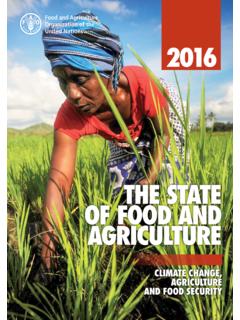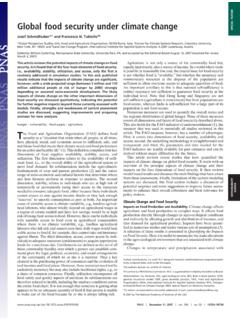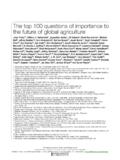Transcription of CLIMATE CHANGE AND FOOD SECURITY - Food …
1 CLIMATE CHANGE AND food SECURITY : A FRAMEWORK DOCUMENT food AND agriculture ORGANIZATION OF THE UNITED NATIONS ROME, 2008 CLIMATE CHANGE and food SECURITY : a framework document iiiFOREWORD CLIMATE CHANGE will affect all four dimensions of food SECURITY : food availability, food accessibility, food utilization and food systems stability. It will have an impact on human health, livelihood assets, food production and distribution channels, as well as changing purchasing power and market flows. Its impacts will be both short term, resulting from more frequent and more intense extreme weather events, and long term, caused by changing temperatures and precipitation patterns, People who are already vulnerable and food insecure are likely to be the first affected.
2 agriculture -based livelihood systems that are already vulnerable to food insecurity face immediate risk of increased crop failure, new patterns of pests and diseases, lack of appropriate seeds and planting material, and loss of livestock. People living on the coasts and floodplains and in mountains, drylands and the Arctic are most at risk. As an indirect effect, low-income people everywhere, but particularly in urban areas, will be at risk of food insecurity owing to loss of assets and lack of adequate insurance coverage. This may also lead to shifting vulnerabilities in both developing and developed countries.
3 food systems will also be affected through possible internal and international migration, resource- based conflicts and civil unrest triggered by CLIMATE CHANGE and its impacts. agriculture , forestry and fisheries will not only be affected by CLIMATE CHANGE , but also contribute to it through emitting greenhouse gases. They also hold part of the remedy, however; they can contribute to CLIMATE CHANGE mitigation through reducing greenhouse gas emissions by changing agricultural practices. At the same time, it is necessary to strengthen the resilience of rural people and to help them cope with this additional threat to food SECURITY .
4 Particularly in the agriculture sector, CLIMATE CHANGE adaptation can go hand-in-hand with mitigation. CLIMATE CHANGE adaptation and mitigation measures need to be integrated into the overall development approaches and document provides background information on the interrelationship between CLIMATE CHANGE and food SECURITY , and ways to deal with the new threat. It also shows the opportunities for the agriculture sector to adapt, as well as describing how it can contribute to mitigating the CLIMATE challenge. Wulf Killmann ChairpersonInterdepartmental Working Group on CLIMATE CHANGE CLIMATE CHANGE and food SECURITY : a framework document vCONTENTS FOREWORD III ACKNOWLEDGEMENTS IX SUMMARY XI ACRONYMS XIII INTRODUCTION 1 1.
5 DEFINING TERMS AND CONCEPTUALIZING RELATIONSHIPS 3 food systems and food SECURITY 3 food SECURITY 3 food system 3 food chain 5 CLIMATE and CLIMATE CHANGE 6 CLIMATE and its measurement 6 CLIMATE system 7 CLIMATE variability and CLIMATE CHANGE 8 Effects of global warming on the CLIMATE system 8 Acclimatization, adaptation and mitigation 8 CLIMATE CHANGE and food SECURITY 9 agriculture , CLIMATE and food SECURITY 9 food SECURITY and CLIMATE CHANGE : a conceptual framework 11 Vulnerability to CLIMATE CHANGE 12 Livelihood vulnerability 27 2. PROTECTING food SECURITY THROUGH ADAPTATION TO CLIMATE CHANGE 31 FAO s strategic approach 31 Living with uncertainty and managing new risks 32 Improving the quality of information and its use 34 Promoting insurance schemes for CLIMATE CHANGE risk 39 Developing national risk management policies 40 Strengthening resilience and managing CHANGE 41 Adjusting consumption and responding to new health risks 41 Intensifying food and agricultural production 42 Creating an eco-friendly energy economy 46 Adapting agriculture -based livelihood strategies 54 3.
6 PROTECTING food SECURITY THROUGH MITIGATION OF CLIMATE CHANGE 59 Reducing emissions 60 Reducing agricultural and forestry emissions of carbon dioxide 60 Reducing agricultural emissions of methane and nitrous oxide 62 Sequestering carbon 65 Reforestation and afforestation 66 Rehabilitating degraded grasslands 67 Rehabilitating cultivated soils 68 Promoting conservation agriculture 69 4. THE WAY FORWARD 71 The institutional setting for addressing food SECURITY and CLIMATE CHANGE linkages 71 The Intergovernmental Panel on CLIMATE CHANGE 71 The United Nations Framework Convention on CLIMATE CHANGE , its Conference of the Parties, the Kyoto Protocol and the Nairobi Worlk Programme 71 CLIMATE CHANGE and food SECURITY .
7 A framework document viAgenda 21 and sustainable agriculture and rural development 72 Integrating adaptation and mitigation 72 Access to funds 73 The UNFCCC CLIMATE CHANGE Funds and the Global Environment Facility 73 The Clean Development Mechanism 74 Other funding sources 74 FAO s role 74 REFERENCES 77 ANNEX I 83 Essential CLIMATE Variables for the Global CLIMATE Observing System, the Global Ocean Observing System and the Global Terrestrial Observing System 83 ANNEX II 85 Internationally Agreed CLIMATE and CLIMATE CHANGE terminology 85 ANNEX III 87 Global Warming and CLIMATE CHANGE 87 CLIMATE CHANGE , global environmental CHANGE and global CHANGE 87 Global warming 87 The carbon and nitrogen cycles 89 ANNEX IV 93 Rules and Conditions for the Clean Development Mechanism 93 CLIMATE CHANGE and food SECURITY : a framework document viiTABLES Table 1.
8 Potential impacts of CLIMATE CHANGE on food systems and food SECURITY , and possible adaptive responses 14 Table 2. Impacts of droughts on livestock numbers in selected African countries, 1981 to 1999 22 Table 3. Employment in agriculture as share of total employment, by region 28 Table 4. Land required to replace 25 percent of current fuel demand for transport (45 EJ/year) 47 Table 5. Distribution of global land area, 2004 48 Table 6.
9 Examples of livelihood groups at risk and adaptation responses for each of ten ecosystems evaluated for the Millennium Ecosystem Assessment 55 Table 7. Global terrestrial carbon sequestration potential 66 Table 8. Agricultural practices for enhancing productivity and increasing the amount of carbon in soils 69 FIGURES Figure 1. Conceptual framework of possible causes of low food consumption and poor nutritional status 4 Figure 2.
10 food system activities and food SECURITY outcomes 5 Figure 3. The formation of CLIMATE 7 Figure 4. Global warming and changes in the CLIMATE system (FAO/NRCB) 10 Figure 5. CLIMATE CHANGE and food SECURITY 13 Figure 6. Steps for selecting adaptation options 32 Figure 7. Steps for designing a strategy to implement the adaptation options selected 33 Figure 8. Methods and tools for assessing CLIMATE CHANGE impacts for different time periods and at various scales 33 Figure 9.












